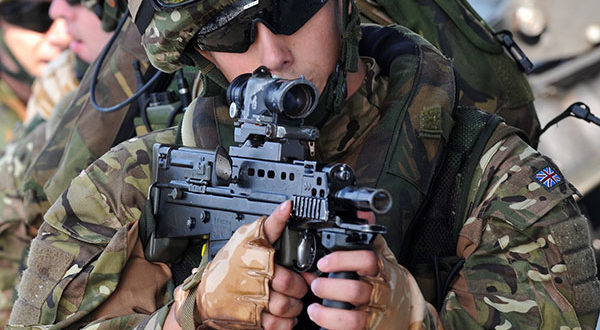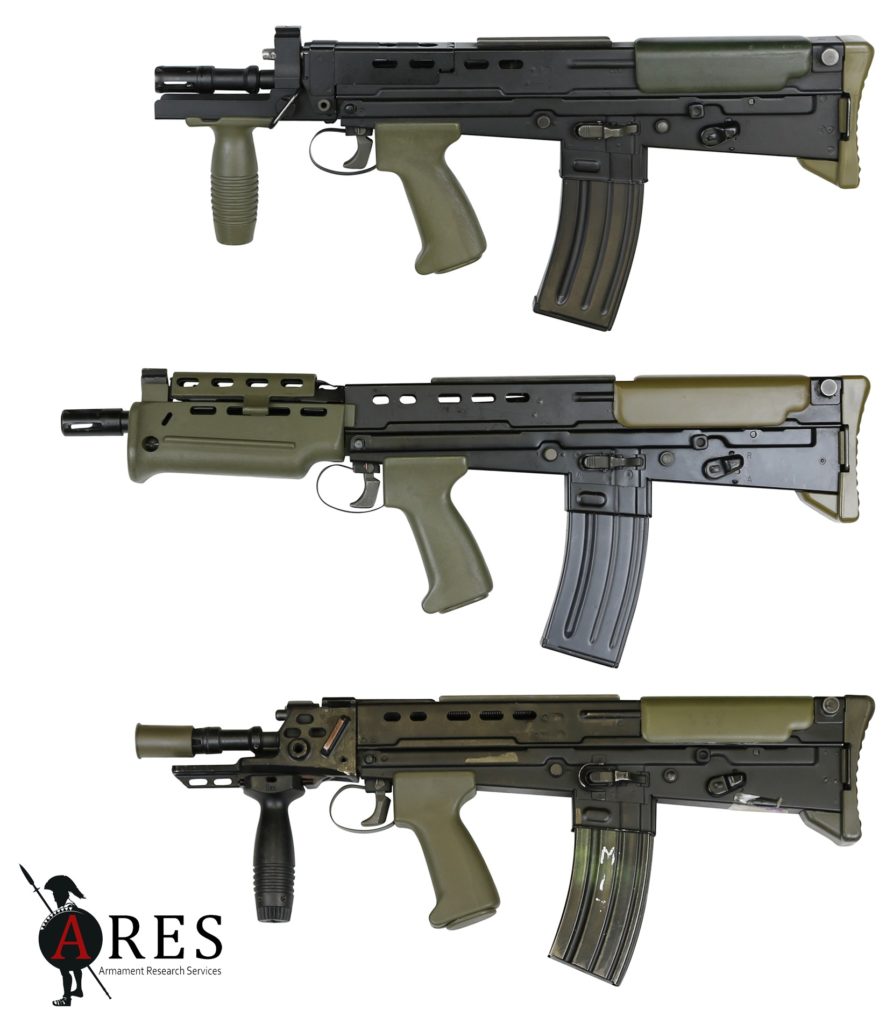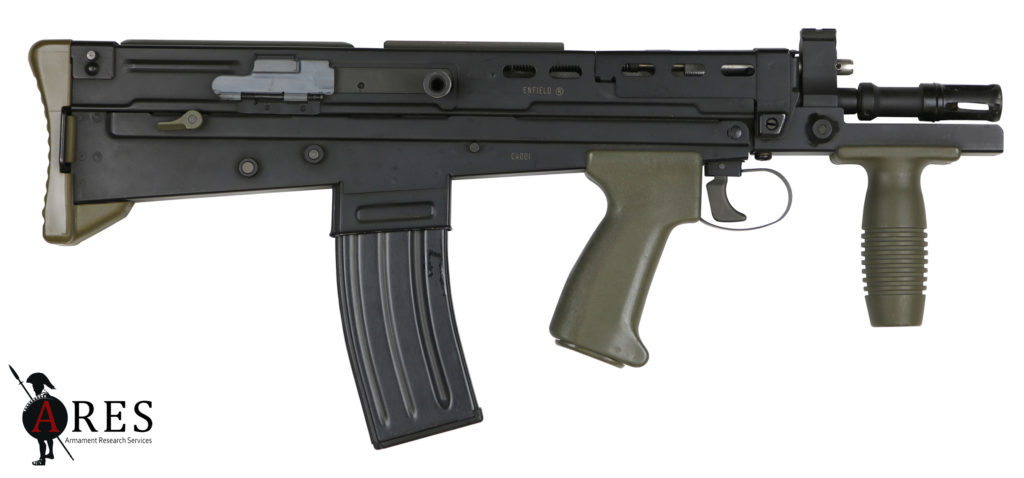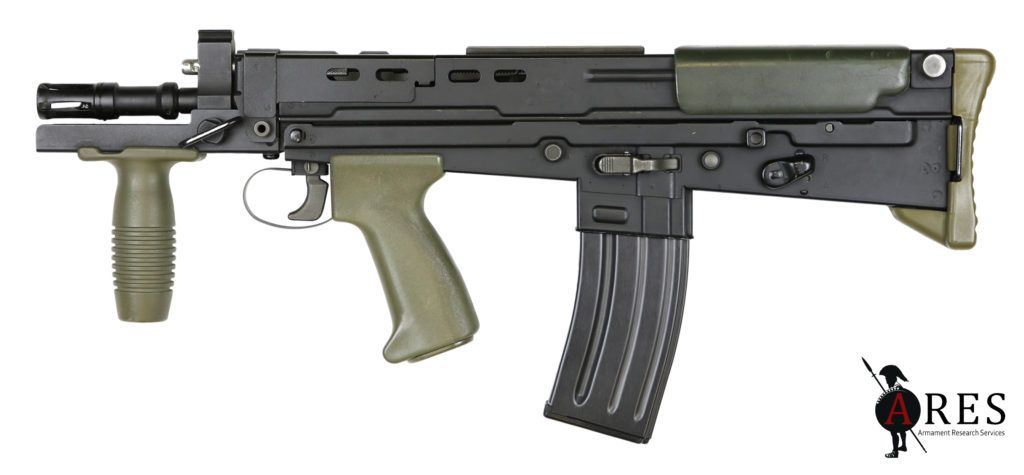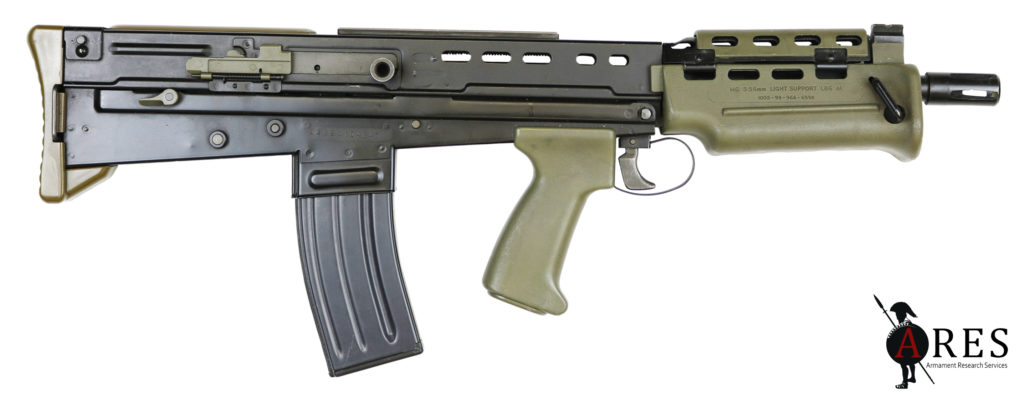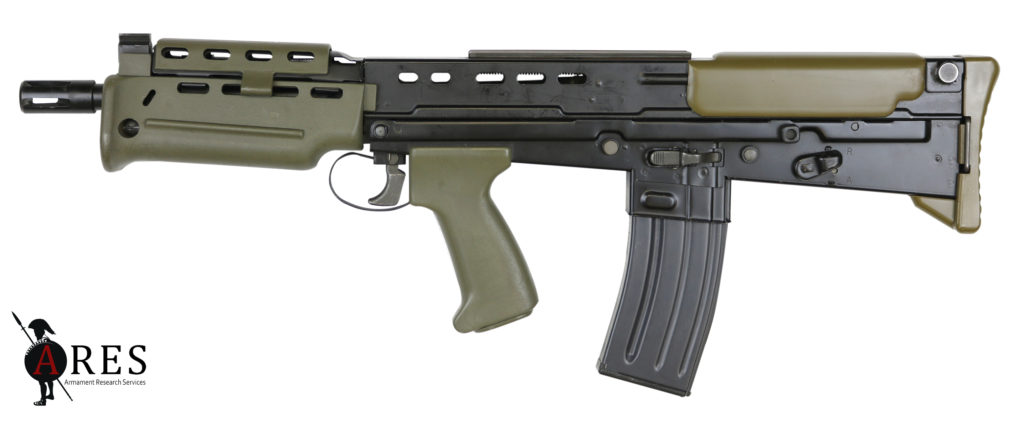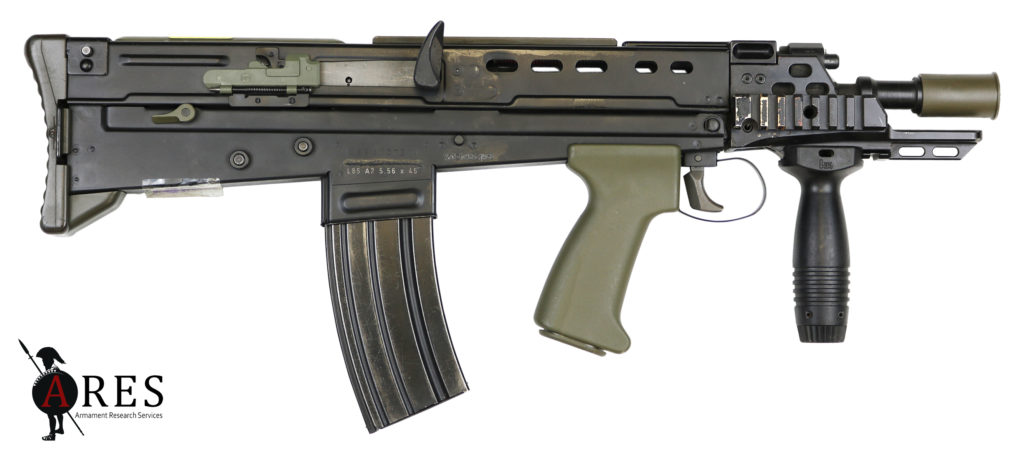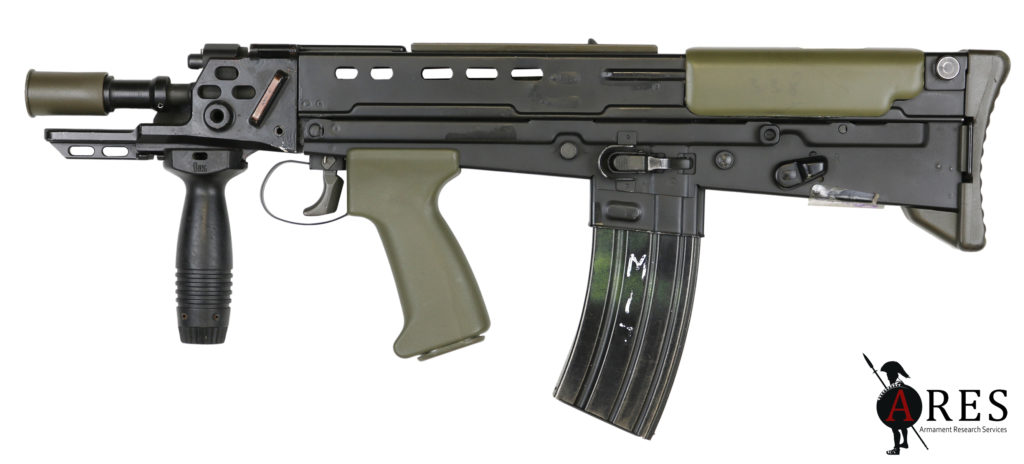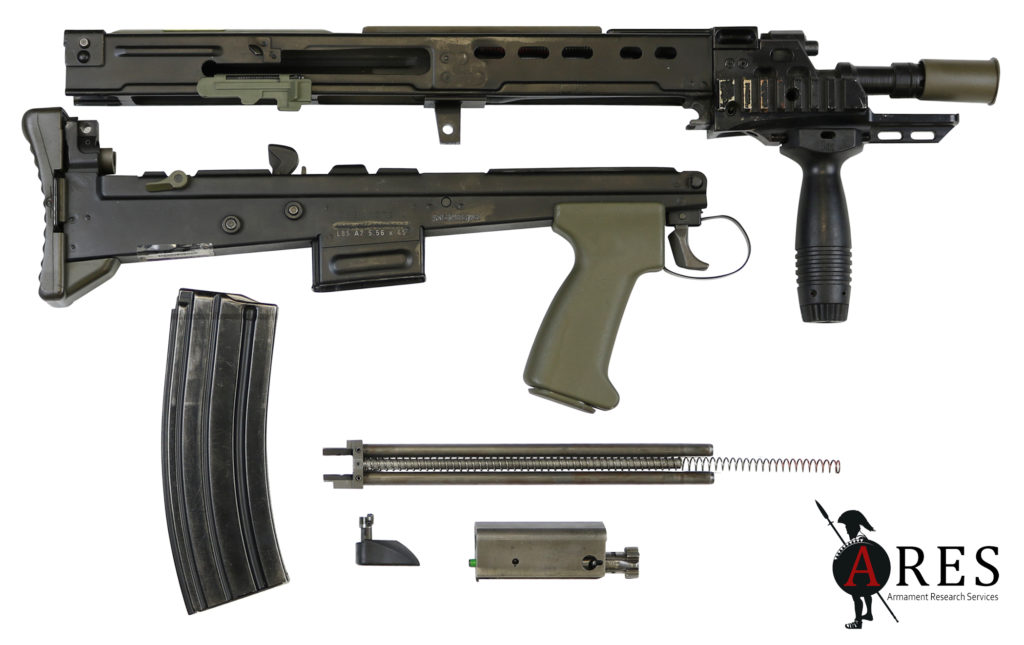Note: The information in this article has been superseded by that published in Jonathan Ferguson’s important original research work, Thorneycroft to SA80: British Bullpup Firearms, 1901–2020. That book is available from the Headstamp Publishing website: https://www.headstamppublishing.com/bullpup-rifle-book
This post accompanies the ninth in a series of collaborative videos produced with ARES Researcher Ian McCollum, who also runs the Forgotten Weapons blog and YouTube channel. Using access to unique collections facilitated by ARES, this series of videos will examine a range of interesting weapons over the coming months. Each video will be accompanied by a blog post, here on The Hoplite, and supported by high quality reference photographs. – Ed.
Jonathan Ferguson
From the inception of the (Section) Small Arms of the 1980s project in 1970, the intent behind British adoption of a bullpup rifle had been to replace as many section (squad) firearms as possible. This included the 7.62 x 51 mm L1A1 Self-Loading Rifle (SLR) and L4A4 (Bren) light machine gun (LMG), as well as the L2A3 Patchett-Sterling sub-machine gun (SMG) in 9 x 19 mm. By 1970, all of these weapons were considered ‘legacy’ designs, outdated in concept, and each designed and manufactured 20 or more years previously. Although the SMG was not excessively powerful, heavy, and expensive to build and maintain like the SLR and LMG, the advent of compact and lightweight small calibre, high velocity (SCHV) designs was casting doubt on its relevance. Even a conventionally laid-out 5.56 x 45 mm automatic rifle could allow an armed force to retire its SMGs, with their limited range and terminal effect. A design in bullpup configuration was even more appealing to some, and the SA80 rifle was developed from the beginning as an ‘SMG killer’. Nonetheless, Enfield did investigate an ultra-compact carbine or sub-machine gun variant at least as early as 1984.
1984 Prototype
In 1984, the L85A1 Rifle and L86A1 Machine Gun gained official approval, and our earliest evidence for an SA80 carbine emerges. This takes the form of an archival photograph, dated November 1984, of an early attempt shown alongside a full-size IW and the Sterling SMG (see Steve Raw’s The Last Enfield, p.216). This is a converted XL64E5 EWS ‘IW’ (Individual Weapon, NATO nomenclature for a rifle or similar arm) in an ultra-short format. The weapon itself is still extant in the former MoD Pattern Room collection, allowing this author to examine it closely. The barrel is 242 mm (9.5”) in length; the shortest barrel ever fitted to an SA80 variant. The barrel and gas block are adapted from surplus XL70E3 components, and so the weapon is chambered for 5.56 x 45 mm. The portion of the barrel forward of the gas block had been turned down to a smaller diameter and left ‘in the white’. The gas block itself was reshaped to accept the new plug, and the upper surfaced bevelled for a low profile.’
The 1984 prototype lacks a muzzle device or any threading, although there is a groove cut at the six o’clock position near the crown that hints at a possible pinned-on muzzle device of some kind.The Body (upper receiver) is crudely cut away on top to expose the gas system, and to offer rudimentary reinforcement, short ‘flaps’ of sheet steel have been folded down against the outside of the Body. In this configuration, the only way to fire the weapon with both hands would be to wrap the support hand around the firing hand as in a modern two-handed pistol shooting hold. The bolt carrier group is the original XL64E5 assembly with its tungsten recoil pellet and dorsal cut-out for use with the XL65E4 LSW’s open bolt automatic mode of fire (at this stage of development, the carrier groups were interchangeable. The bolt itself is also the original pattern, with deeply relieved ‘neck’ to accommodate the huge extractor. Overall, this early effort was not well designed, and the operating rod appears to have bent during testing.
It is curious that Enfield should base this weapon upon the XL60 series, as by 1984 the current variant was the substantially redesigned (X)L80 version. Yet the evidence speaks for itself; not only is there no earlier evidence of work on a carbine, the gas block on this first prototype is that of an (X)L80 series weapon. The recycling of an older prototype suggests that this was not an attempt to ‘sell’ the concept of a carbine to the UK military (in which case a more ‘current’ variant would have been used). It was likely just an in-house project, perhaps anticipating a military requirement that had yet to be articulated. Whenever it was first explored, the deliberate shortening of an SA80 down to exactly the length of a Sterling with folded stock is telling. It suggests that the justification for such a weapon was that an SMG in the Personal Defence Weapon role might be used with its stock folded. Not only might there not be time to deploy the stock (especially the ingenious but over-engineered Sterling stock) in an emergency, but users might actually still be in the confines of a vehicle or aircraft when they needed their weapon. The Sterling with its stock closed was substantially shorter than the L85A1, and the latter was much bulkier and heavier to boot. No feedback on this attempt survives today, and it would be another few years before the idea was tried again.
1989 Prototype
In 1989 a short run of unnamed carbines was built from L85A1 parts (as evidenced by the lack of the four attachment holes for the outrigger; at this time only LSW Bodies were so modified). These weapons were, superficially at least, remarkably similar to the current in-service design. They featured a barrel of similar length to the 1984 iteration, this time measuring 310 mm (12.2”) including flash-suppressor. The new design was mechanically different, however. As might be expected, the gas system was shortened quite dramatically. This would have affected the functioning of the weapon. Gas pressure would have been increased, but the operating duration would be reduced, most likely resulting in ‘short-stroking’. Presumably to address this, the bolt carrier was lightened with a deep v-shaped groove on top. This appears to have induced further problems (perhaps excessive carrier velocity and therefore undesirable wear to the weapon). To address this, in turn, the return spring was augmented with a second internal (‘nested’) spring. The H&K solution to the problem of a ‘shorty’ SA80 was far more elegant (see below). It should be noted that Raw (p.221) incorrectly describes these mechanical changes as having been applied to the 1994 prototype (see below). Raw also speculates that these changes were made to increase the rate of fire, but this seems an unlikely and undesirable purpose in light of the pressure change/carrier velocity explanation.
The installation of a standard L85A1 flash-suppressor, and a sheet-metal ‘outrigger’ below it to protect the firing hand, permitted a proper two-handed hold on the 1989 gun. To facilitate this, an LSW rear grip was permanently fitted as a vertical foregrip. These guns were serial numbered in the range ‘CA 00X’, and the Body was marked with the commercial ‘ENFIELD®’ trademark. No service designation is applied; these were never introduced into British (or any other) military service. However, they are not quite prototypes either, as they were advertised for sale by Royal Ordnance. A handful still exist, divided between the Royal Armouries and Shrivenham (Defence Academy of the UK) weapons collections. Raw (p.219) suggests that a small quantity were sold to an unspecified Middle Eastern country, but were destroyed in a warehouse fire and were therefore never issued. Clearly this product failed commercially, and it does not appear to have been seriously trialled by the British MoD.
1994 Prototype
After Enfield had closed and SA80 production had moved to Nottingham, Royal Ordnance plc experimented with yet another carbine-length SA80. This was again based on the L85A1, but featured a longer barrel and a complete LSW handguard, with just the birdcage portion of the long L85 flash-suppressor protruding from the flat front of the handguard. To accommodate this arrangement, the gas block (with its integral front sight base) had to be machined off. With a perceived requirement for iron sights, a second gas block was installed further down the barrel, with its gas plug hole left unfilled and, as before, a carrying handle with its integral rear sight was installed. As per the 1989 prototype, no major changes were made to the mechanical components of the gun, other than a shortened operating rod, about 1″ shorter than the full-length L85 equivalent. The intent here seems to have been to move the gas port only as far as necessary for proper function. The weapon’s longer 390 mm (15.4”) barrel may also have been an attempt to maintain reliability whilst sacrificing a greater reduction in overall length. This variant also failed to enter military service or garner any export sales.
L22A2
In 2003, with the SA80 now the weapon system that it should have been in 1985, attention turned once again to the development of a carbine model. This time, the requirement seems to have originated from the military. As with the A2 rifle and LSW, the new L22A2 carbine received the benefit of Heckler & Koch’s long experience in firearms design and manufacture. The prototype seen here is a converted L85A2, and is marked as such. The bolt carrier group has not been changed, and in fact minimal engineering changes were made to the weapon. H&K focused on the gas plug, both reducing its internal diameter to compensate for the increased gas pressure of the shorter gas system, and lengthening it to increase duration (approximately 2.5 mm extra travel). This at last successfully balanced the weapon’s time/pressure curve. The plug was also altered externally, with twin lugs to permit more convenient removal from the front of the gas block. The ‘excessive’ and ‘off’ positions were deleted, and the operating rod was of course shortened.
The new front end is finished with a specifically- designed vented aluminium heat-shield/rail accessory system, with Picatinny rails at the 6 o’clock and 3 o’clock positions. The latter is often used to mount the Laser/Light Module (LLM) or a stand-alone mounted flashlight. In either case, an activation switch is sleeved onto the foregrip. No rail is provided on the left side, allowing space for an angled sling loop (the standard butt-plate/rear loop remains in place, and the single-point sling appears to be favoured in service). A flat cover is hinged and clipped in place over the gas cylinder/operating rod. An H&K vertical foregrip (a ‘downgrip’ in British military parlance) is furnished as standard. This can be removed or relocated on its length of rail by unscrewing the adjustment cap at its base. Alternatively, for an even more compact package, the folding foregrip issued for use on the L129A1 Sharpshooter rifle may be fitted (and is apparently standard equipment on those L22A2 rifles issued to British Army Apache helicopter crews; see the image below). This grip is adjustable into one of five angled positions. In either case, a substantial forward extension to the weapon’s rail system prevents installation too far forwards, and significantly reduces the chance of injury to the support hand, although this will always remain a training issue for such a short barrelled weapon. Due to the very short sight radius, previous attempts to provide a backup iron sight system on the weapon itself were abandoned. Instead, the SUSAT or LDS optics both possess Emergency Backup Sights. A 20 round magazine is available to maintain the weapon’s compact silhouette as befits an AFV crew PDW, but of course the standard 30 round magazine of the rifle/LSW is interchangeable. Although the L22A2 is frequently supposed to be a conversion of the L86A1/A2 LSW, in fact there is no evidence of this and detailed inspection suggests that they are assembled from surplus L85A1 parts plus newly manufactured H&K components.
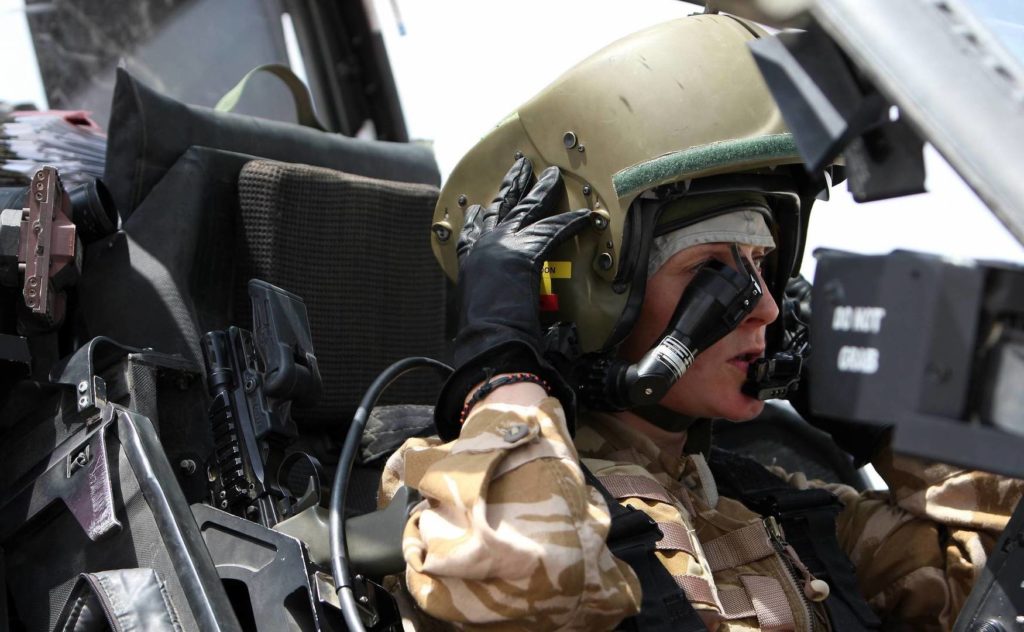
Note L22A2 rifle, at left, fitted with shorter folding foregrip as issued with L129A1 Sharpshooter rifles (photo credit: British Army).
The L22 is issued as a standard personal weapon for AFV crews of the Royal Armoured Corps, and is also to be found stowed in the cockpit of Army Air Corps WAH-64 (Apache AH Mk.1) attack helicopters as not just an aircrew survival weapon but a compact personal weapon, as befits a corps of soldier-aviators. For this application, a special holster is attached to the right side of each crewmember’s seat. It is also provided for use by Royal Navy and Royal Marines boarding parties. As to the effectiveness of the design, it is the nature of an emergency use weapon that it is less likely to see use in combat, since if it does, something has gone badly wrong. As a result, we have no real feedback on the effectiveness of the weapon, but equally, there appear to have been no complaints either. There is of course a loss in muzzle velocity, from the 930 m/s of the rifle down to 780. The state effective range for accurate rapid fire is 200 metres – 100 m less than the 300 m of the Rifle – but is of course dependent upon training, skill, and circumstances. In doctrinal terms, it is regarded and treated as a rifle.
A Note on Nomenclature
It is important to note that there remains a good deal of confusion over the official designation of the L22 Carbine. Some official documentation has given the name as “Carbine, 5.56 mm, L22A2”, yet as of 2014 some contemporary official literature uses ‘L22A1’. Yet all of the the actual weapons are marked ‘L22 A2 5.56 x 45’. Regardless of this discrepancy, the Enfield and Nottingham-built prototypes were never designated, as they are sometimes assumed to have been, ‘L22A1’. The L22 is also occasionally (but nonetheless officially) referred to as ‘SA80K’, and was at one time nicknamed ‘Stubby K’.
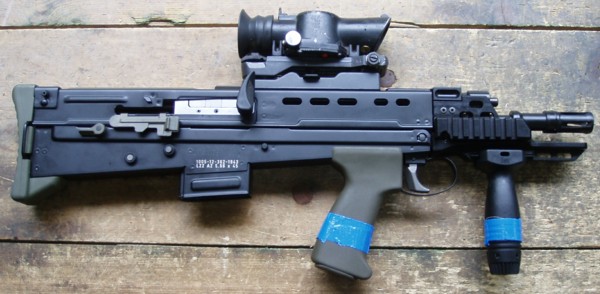
L22A2 self-loading rifle with service markings (photo credit: Tony Williams).
Technical Specifications (L22A2 Carbine)
Calibre: 5.56 x 45 mm
Overall length: 571 mm
Barrel length: 327 mm (11.2”) (285 mm ex. flash suppressor)
Weight (unloaded with SUSAT): 3.52 kg (7.76 lbs)
Feed device: 20- or 30-round detachable magazine
Note: The information in this article has been superseded by that published in Jonathan Ferguson’s important original research work, Thorneycroft to SA80: British Bullpup Firearms, 1901–2020. That book is available from the Headstamp Publishing website: https://www.headstamppublishing.com/bullpup-rifle-book
Special thanks to the National Firearms Centre at the Royal Armouries, who graciously allowed us access to their world-class collection for this and other videos and photos. Thanks are also due to Mike Sterry, for his assistance with some of the finer technical details.
This is Part 6 in a series of posts examining the developmental history of the United Kingdom’s SA80 family of small arms. Part 1 is available here, Part 2 is available here, Part 3 is available here, Part 4 is available here, and Part 5 is available here. Stay tuned for the next instalment in this series of posts and videos examining the history of the SA80 weapons programme, here on The Hoplite.
Header image shows a Royal Marines Commando with an L22A2 self-loading rifle. Photo copyright: UK Ministry of Defence.
Remember, all arms and munitions are dangerous. Treat all firearms as if they are loaded, and all munitions as if they are live, until you have personally confirmed otherwise. If you do not have specialist knowledge, never assume that arms or munitions are safe to handle until they have been inspected by a subject matter specialist. You should not approach, handle, move, operate, or modify arms and munitions unless explicitly trained to do so. If you encounter any unexploded ordnance (UXO) or explosive remnants of war (ERW), always remember the ‘ARMS’ acronym:
AVOID the area
RECORD all relevant information
MARK the area from a safe distance to warn others
SEEK assistance from the relevant authorities

